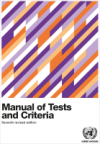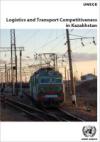Publications
Displaying Results 21 - 40 of 161
- English
This Handbook for national master plans for freight transport and logistics has been elaborated with the aim to showcase the importance of the freight sector for the national economic development, and more importantly to assist national authorities in charge of freight transport and logistics with potential actions in accompanying the sector development to follow a sustainable path in support of
- English
While the second half of 2020 was marked by the warranted fight against the COVID-19 pandemic which continued to change the face of the world, our ambitions for a better global road safety were not scaled back. COVID-19 has taught us to move away from the “silo mentality” and instead align development goals with each other - resulting in higher impact policies and programs.
- English
The UN Road Safety Fund was established in 2018 as a UN multi-partner trust fund pursuant to the General Assembly resolution 70/260 and with the support of the UN Secretary-General. It aims to help low- and middle-income countries put in place an effective national Safety System to substantially
- English
Updated Guidelines on the use of the UNRSF brand and logo
- Français
L’ADR, fait à Genève le 30 septembre 1957 sous l'égide de la Commission économique des Nations Unies pour l'Europe, est entré en vigueur le 29 janvier 1968.
Cet Accord est destiné à accroître la sécurité du transport international de marchandises dangereuses par route. Ses annexes A et B imposent les conditions dans lesquelles les marchandises dangereuses, lorsqu'elles ne sont pas interdites,
- English
Adopted on 30 September 1957 in Geneva under the auspices of the United Nations Economic Commission for Europe (UNECE), the ADR entered into force on 29 January 1968.
This authoritative Agreement is intended to increase the safety of international transport of dangerous goods by road. Its Annexes A and B contain the technical requirements for road transport, i.e. the conditions under which
- English
The UNRSF launches the second issue of its newsletter at a time when the world continues to face unprecedented change and disruptions due to the Covid-19 pandemic. However, the momentum gained with the 3rd Global Ministerial Conference on Road Safety in February 2020 where the Stockholm Declaration was launched with an ambitious target to reduce road deaths and injuries by 50% by 2030 must not
- English
The UN Road Safety Fund’s (UNRSF) secretariat seeks additional financial support from private and public sector donors where the Fund’s mission and donor priorities are aligned. Read more in the UNRSF donor brochure to consider becoming a donor.
Contact the UNRSF secretariat for more information at unrsf_secretariat
- English
The UNRSF 2019 Annual Report is now available. Established two years ago as an innovative United Nations pooled fund, the Annual Report showcases the first concrete results of the UNRSF and thus demonstrates its potential to meet its ambition to substantially reduce death and injuries from road crashes in low and middle-income countries where 93% of the world fatalities occur.
- English
Organizations around the world are quickly adapting their programme and project activities to respond to the COVID-19 pandemic and its consequences. The UN Road Safety Fund is committed to the principles of adaptive programming, partnerships, and relevance. The operationalization of these principles is even more critical during this unparalleled time. This flyer provides tools and tips for
- English
The April 2020 marks the second anniversary of the launch of the United Nations Road Safety Fund (UNRSF). The Fund is now financing 15 projects in 20 low- and middle-income countries to substantially reduce death and injuries from road crashes and to reduce economic losses resulting from these crashes.
- English
As part of the ongoing work on THE PEP a Study on good practices in Mobility Management has been published.Drawing on concrete experiences from across the Pan-European region, the guide, developed under the Transport Health and Environment Pan-European Programme (THE PEP), provides practical policy considerations enriched by a total of 22 good practices from 17 countries that set out the
- English
The Contracting Parties to the TIR Convention launched in 2003 the so-called “eTIR Project”, aimed at providing an exchange platform for all actors (Customs authorities, holders and guarantee chains) involved in the TIR system, known as the “eTIR international system” (Customs to Customs).The eTIR international system aims to ensure the secure exchange of data between national Customs systems
- English
A study on the transport infrastructure and services available in Kyrgyzstan. This document reviews the country’s extensive recent and future transport investments, and sets out recommendations to ensure its transport network is ready to harness the growth in inland transport from rising Asia-Europe trade, particularly in the context of the Belt and Road Initiative.
- English
ST/SG/AC.10/11/Rev.7
Sales No. E.20.VIII.1
ISBN 978-92-1-130394-0
eISBN 978-92-1-004503-2
Languages: E, F, (A, C, R, S forthcoming)
How to order this publication?
This publication is also available online for free (download).
The "Manual of Tests and Criteria" contains criteria, test methods and
- English
These recommendations have been developed in the light of technical progress, the advent of new substances and materials, the exigencies of modern transport systems and, above all, the requirement to ensure the safety of people, property and the environment. They are addressed to governments and international organisations concerned with the regulation of the transport of dangerous goods. The
- English
The GHS addresses classification of chemicals by types of hazard and proposes harmonized hazard communication elements, including labels and safety data sheets. It aims at ensuring that information on physical hazards and toxicity from chemicals be available in order to enhance the protection of human health and the environment during the handling, transport and use of these chemicals.
The GHS
- English
Improving the competitiveness of Kazakhstan as a transport logistics centre at the crossroads of Europe and Asia could enable the country to unlock significant untapped benefits of growing cargo flows between the two continents. This study identifies the transport infrastructure and services available in Kazakhstan, reviews the country’s extensive recent and future transport investments,


















